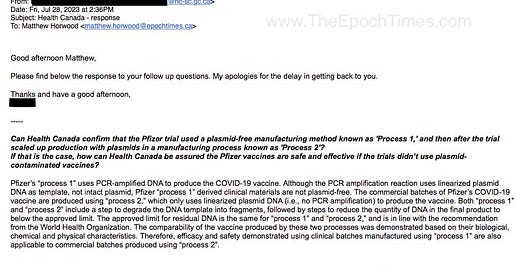From:
Forwarded message
Date: Fri, Jul 28, 2023 at 2:36PM
Subject: Health Canada - response
@hc-sc.gc.ca>
To: Matthew Horwood <matthew.horwood@epochtimes.ca>
www.TheEpoch Times.com
Good afternoon Matthew,
Please find below the response to your follow up questions. My apologies for the delay in getting back to you.
Thanks and have a good afternoon,
Can Health Canada confirm that the Pfizer trial used a plasmid-free manufacturing method known as 'Process 1,' and then after the trial scaled up production with plasmids in a manufacturing process known as 'Process 2'?
If that is the case, how can Health Canada be assured the Pfizer vaccines are safe and effective if the trials didn't use plasmid- contaminated vaccines?
Pfizer's "process 1" uses PCR-amplified DNA to produce the COVID-19 vaccine. Although the PCR amplification reaction uses linearized plasmid DNA as template, not intact plasmid, Pfizer "process 1" derived clinical materials are not plasmid-free.
The commercial batches of Pfizer's COVID-19 vaccine are produced using "process 2," which only uses linearized plasmid DNA (i.e., no PCR amplification) to produce the vaccine. Both "process 1" and "process 2" include a step to degrade the DNA template into fragments, followed by steps to reduce the quantity of DNA in the final product to below the approved limit.
The approved limit for residual DNA is the same for "process 1" and "process 2," and is in line with the recommendation from the World Health Organization.
The comparability of the vaccine produced by these two processes was demonstrated based on their biological, chemical and physical characteristics. Therefore, efficacy and safety demonstrated using clinical batches manufactured using "process 1" are also applicable to commercial batches produced using "process 2".
Can you point to the testing data analyzed by Health Canada on the issue? Is it public? Also, are the PCR primers and probes used to make this assessment public?
Testing data analyzed by Health Canada, as well as the PCR primers and probes used, are proprietary information of the vaccine manufacturer.
They are not public information.
However, the methods used for measuring residual DNA fragments were appropriately validated by the manufacturer and evaluated as fit for purpose by Health Canada.
In addition, all Pfizer COVID-19 vaccine commercial batches released in Canada complied with the requirements approved by Health Canada, including the residual DNA.
McKernan asserts that the Pfizer vaccines contain an SV40 Enhancer sequence that is commonly used for gene therapy, but this sequence was not disclosed to the EMA. Do you have information on that matter?
Health Canada cannot comment on information provided to another regulatory authority.
Health Canada expects sponsors to identify any biologically functional DNA sequences within a plasmid (such as an SV40 enhancer) at the time of submission.
Although the full DNA sequence of the Pfizer plasmid was provided at the time of initial filing, the sponsor did not specifically identify SV40 sequence.
When the presence of the SV40 enhancer was raised publicly by McKernan and Buckhaults, it was possible for Health Canada to confirm the presence of the enhancer based on the plasmid DNA sequence submitted by Pfizer against the published SV40 enhancer sequence.
As mentioned in response to the first question, the residual plasmid DNA is present in the final product as DNA fragments, due to the enzyme digestion step in the downstream process. As such, the original risk benefit analysis that supported the initial approval of the Pfizer vaccine continues to be valid.
Finally, information contained here indicates that plasmids are able to enter the nuclei of cells. Is it inaccurate? https://www.urmc.rochester.edu/labs/dean/projects/nuclear-targeting-of-plasmids-and-protein-dna-comp.aspx
The information on the above website suggests that intact plasmids containing the SV40 enhancer sequence can translocate to the nucleus of cells in culture.
However, this information has not been peer reviewed, hence its validity has not been verified.
In addition, the DNA plasmid used for the Pfizer vaccine production is linearized, degraded, and reduced in quantity through additional steps.
There is no peer reviewed evidence that linearized or fragmented DNA is capable of translocating to the nucleus of cells.
Also this paper discusses genomic integration and seems to contradict your statement about it not being of concern. Is it inaccurate? https://www.nature.com/articles/s41434-021-00278-2
The paper cited provides evidence that adenovirus vectors have the potential to integrate into genomic DNA.
The plasmid used to prepare the Pfizer vaccine does not contain adenovirus virus sequences.
Furthermore, as noted in the response to the previous question, there is no evidence that fragmented DNA is capable of translocating to the nucleus of cells.-




Thank you for info/link/update.